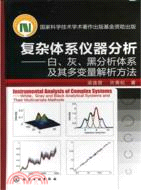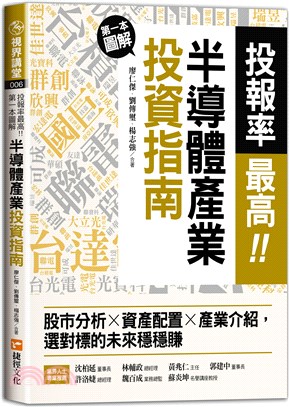商品簡介
此書可作為從事化學計量學學習與研究的分析工作者的參考書,亦可作為分析化學專業高年級本科生和研究生的教學參考書。
名人/編輯推薦
目次
第一章 概論 (Introduction)
第一節 現代分析化學面臨的機遇與挑戰(Opportunity and Challenge Faced by Modern Analytical Chemistry)
第二節 化學計量學的多變量解析思路(Thoughts on Chemometric Multivariate Analysis)
第三節 化學計量學中的軟模型和硬模型 (Soft Modeling and Solid Modeling in Chemometrics)
參考文獻11Chapter
第二章 分析化學中的幾個理論思考問題(Several Theoretic Problems in Analytical Chemistry)
第一節 分析化學的信息理論(Information Theory on Analytical Chemistry)
第二節 張量校正理論(Theory of Tensor Calibration)
第三節 黑、白、灰多組分體系及儀器分析策略(White,Grey and Black Analytical Systems and Strategy of Instrumental Analysis)
參考文獻18Chapter
第三章 白色分析體系的多元校正方法(Multivariate Calibration Methods for White Analytical Systems)
第一節 直接校正方法(Direct Calibration Method)
一、多元線性回歸方法(Multiple Linear Regression)
二、Kalman濾波法(Kalman Filtering)
三、加權最小二乘回歸法(Weighted Least Squares)
第二節 間接校正方法(Indirect Calibration Method)
一、K矩陣法(Kmatrix Method)
二、P矩陣法(Pmatrix Method)
三、主成分回歸法(Principal Component Regression)
四、偏最小二乘法(Partial Least Squares)
第三節 通用標準加入法(Generalized Standard Additive Method)
第四節 廣義內標法(Generalized Internal Reference Method)
第五節 非線性體系的人工神經網絡校正方法 (Calibration Method Based on Artificial Neurol Network for Nonlinear Systems)
第六節 病態體系的嶺回歸法估計方法 (Illconditioned System and Ridge Regression Estimating Method)
第七節 多元校正的分析化學品質因數和可靠性分析(Figures of Merit of Analytical Chemistry and Reliable Analysis for Multivariate Calibration)
參考文獻52Chapter
第四章 灰色分析體系的多元校正方法(Multivariate Calibration Methods for Grey Analytical Systems)
第一節 矢量校正方法(Vectorial Calibration Methods)
一、投影算法和多元校正模型的檢驗(Projection Algorithm and Testing of Multicalibration Method)
二、標準加入迭代目標轉換因子分析法(Additional Itarative Target Transformation Factor Analysis)
三、自適應Kalman濾波法(Adaptive Kalman Filtering Method)
四、局部曲線擬合法(Local Curve Fitting Method)
第二節 矩陣校正方法 (Matrix Calibration Methods)
一、秩消失因子分析法(Rank Annihilation Factor Analysis)
二、廣義秩消失因子分析法(Generalized Rank Annihilation Factor Analysis)
三、殘差雙線性分解法(Residual Bilinearization Method)
四、約束背景雙線性分解法(Constrained Background Bilinearization Method)
參考文獻79Chapter
第五章 黑色分析體系的多元分辨方法(Multivariate Resolution Methods for Black Analytical Systems)
第一節 基于主成分分析的體系組分數確定方法(Methods Based on Principal Component Analysis for Estimating Number of Chemical Components in Systems)
一、誤差擾動下的協方差陣特征值變化限制(Varying Limits of Eigenvalues of Covariance Matix under Error Disturbance)
二、因子分析的誤差理論(Error Theory of Factor Analysis)
三、主因子數確定的幾種方法(Several Methods for determining Number of Principal Factors)
第二節 矩陣分辨方法(Matrix Resolution Methods)
一、自模式曲線分辨法(Selfmodeling Curve Resolution Method)
二、迭代目標轉換因子分析法(Iterative Target Transformation Factor Analysis)
三、漸進因子分析法及其相關方法(Evolving Factor Analysis and Related Methods)
四、窗口因子分析法(Window Factor Analysis)
五、直觀推導式演進特征投影法(Heuristic Evolving Latent Projections)
六、正交投影分辨法(Orthogonal Projection Resolution Method)
七、子窗口因子分析法(Subwindow Factor Analysis)
八、二維色譜的一階微分矩陣順序秩分析方法(Sequential Rank Analysis of FirstOrder Differentiated Matrix of Twoway Chromatographic Data)
第三節 張量分辨方法(Tensor Resolution Method)
一、投影旋轉因子分析法(Projection Rotation Factor Analysis)
二、廣義秩消失因子分析法(Generalized Rank Annihilation Factor Analysis)
參考文獻150Chapter
第六章 廣義灰色分析體系的多元校正模型(Multivariate Calibration Methods for Generalized Grey Analytical Systems)
第一節 近紅外光譜與廣義灰色分析體系 (Near Infrared Spectroscopy and Generalized Grey Analytical Systems)
第二節 廣義灰色分析體系的模型校驗方法(Model Validation for Generalized Grey Analytical Systems)
一、模型過擬合與潛變量回歸模型(Overfitting and Latent Variable Regression Modeling)
二、模型復雜度與預測標準的提出(Model Complexity and Preditive Criterion)
三、檢驗集的構造與模型交叉校驗(Contruction of Test Dataset and Modeling Crossvalidation)
四、交叉校驗的幾種方法(Several Methods for Crossvalidation)
第三節 廣義灰色分析體系的常用多元校正方法(Common Multivariate Calibration Methods for Generalized Grey Analytical Systems)
一、主成分與偏最小二乘回歸(Principal Component and Partial Least Squares Regression)
二、人工神經網絡(Artificial Neural Network)
第四節 回歸建模中的穩健方法(Robust Methods for Regression Modeling)
一、回歸診斷方法(Regression Diagnostic Methods)
二、穩健回歸方法(Robust Regression Methods)
參考文獻181Chapter
第七章 復雜分析體系多變量數據的模式分析與模式識別(Pattern Analysis and Pattern Recognition Upon Multivariate Data of Complex Analytical Systems)
第一節 概論(Introduction)
一、模式空間的幾種距離與相似性度量(Several Measures of Distance and Similarity in Pattern Space)
二、特征抽取方法(Feature Extraction Methods)
三、常見數據預處理方法(Commonly Used Pretreatment Methods for Multivariate Data)
第二節 多變量數據的模式識別及模式分析(Pattern Recognition and Pattern Analysis for Multivariate Data)
一、有監督的模式識別方法——判別分析法(Supervised Pattern Recognition Methods-Discriminant Analysis Methods)
二、無監督的模式識別方法——聚類分析法(Unsupervised Pattern Recognition Methods-Clustering Analysis Methods)
三、基于特征投影的降維顯示方法(Visual Dimensional Reduction Based on Latent Projection)
四、基于機器學習的分類回歸方法(Classification and Regression Methods Based on Machine Learning)
參考文獻239Chapter
第八章 模型集群分析及新型化學計量學算法的開發研究(Model Population Analysis and Research on Developing New Chemometric Algorithms)
第一節 現代儀器分析數據的特點及其挑戰性(Characteristics and Challenges of Modern Instrumental Analytical Data)
第二節 一次性建模思路的數據分析方法的缺陷(Drawback of Single Data Modeling Analysis)
第三節 模型集群分析——一種新算法開發的一般框架(Model Population Analysis-A General Framework for Developing New Algorithms)
一、有關模型集群分析的幾個實例(Several Examples of Model Population Analysis)
二、蒙特卡洛采樣與機器學習和化學計量學算法(MonteCarlo Sampling Machine Learning and Chemometric Algorithm)
三、模型集群分析的主要思路(Major Idea of Model Population Analysis)
第四節 基于模型集群分析的新算法開發(Developing New Types of Algorithms Based on Model Population Analysis)
一、基于蒙特卡洛采樣的奇異樣本的回歸診斷與篩選(Regression Diagnosis and Screening of Outliers Based on MonteCarlo Sampling)
二、子窗口重排分析(Subwindow Permutation Analysis,SPA)
三、邊界影響分析(Margin Influence Analysis,MIA)
第五節 關于算法研究的一些展望(Some Perspectives on Developing New Algorithms)
參考文獻265Chapter
第九章 復雜分析體系的氣相色譜質譜聯用儀器數據的定性及結構解析初探 (Primary Analysis Based on Chromatographic Retention Indices and Mass Spectral Elucidation)
第一節 氣相色譜的保留指數及其定性分析應用(Retention Index of Gas Chromatography and Its Application for Qualitative Analysis)
一、Kovats保留指數(Kovats Retention Index)
二、程序升溫保留指數(Programmedtemperature Retention Index,PTRI)
三、程序升溫保留指數標準化(Standarization of Programmedtemperature Retention Index)
四、不同色譜條件下程序升溫保留指數的相互轉換(Conversion between Programmedtemperature Retention Indices Under Different Chromatographic Conditions)
第二節 質譜圖解析基本原理(Elements for Elucidation of Mass Spectrum)
一、主要離子類型及其在質譜解析中的作用(Main Types of Ions and Their Application in Interpretation of Mass Spectra)
二、中性丟失(Neutral Losses)
三、質譜解析的步驟(Classic Procedures of Interpretation of Mass Spectra)
第三節 離子裂解基本原理 (Elements for Fragmentation)
一、蠖狹眩 Cleavage)
二、自由基中心引發的岫狹遜從(Cleavage Induced by Radical Site)
三、電荷中心誘導的i裂解(i Cleavage Induced by Charge Sites)
四、環的裂解 (Cleavage of Ring)
五、自由基誘導的重排反應 (Radical Site Rearrangements)
六、電荷誘導的重排反應(Charge Site Rearrangements)
第四節 質譜特征挖掘與保留指數結合用于化合物結構鑒定(Identification of Compound Structure by Data Mining of Mass Spectra and Retention Indices)
一、質譜特征結合保留指數用于質譜數據的定性分析(Mass Spectral Characteristics,Retention Indices Rules and Their Application in Identification)
二、專用數據庫的建立(Establishment of Customized Library)
三、儀器間質譜差異的消除及其在定性順反異構中的應用(Elimination of Mass Spectral Instrumental Difference and Its Application in Identification of cistrans Isomers)
第五節 質譜解析的量子化學解釋初探(Primanery Study on Mass Spectral Eluciation Based on Quantum Chemistry)
一、EI質譜解析中初始電離位點的確定方法(Determinination of Initial Ionization Position for EI Mass Spectral Eluciation)
二、電噴霧離子源(ESI)質譜解析的量化計算研究 (Study on Quantum Chemistry Calcalation for ESI Mass Spectral Eluciation)
參考文獻
第二部分 應用篇(Part Ⅱ: Applications)355Chapter
第十章 中藥分析體系的色譜指紋圖譜技術及其質量控制 (Chromatographic Fingerprinting Techniques of Traditional Chinese Medicines and their Quality Control)
第一節 概論(Introduction)
一、中藥色譜指紋圖譜——中藥高通量分析的化學表征(Chromatographic Fingerprinting-High Throughput Technique for Chemical Characteristics of Traditional Chinese Medicines)
二、中藥色譜指紋圖譜在中藥現代化研究中的核心地位(The Core Status of Chromatographic Fingerprinting Technique in the Research on Modernization of Traditional Chinese Medicines)
第二節 中藥色譜指紋圖譜的預處理方法(Preprocessing Methods for Chromatographic Fingerprints of Traditional Chinese Medicines)
一、中藥色譜指紋圖譜的信息特征(Informative Features of Chromatographic Fingerprints of Traditional Chinese Medicines)
二、中藥色譜指紋圖譜的漂移背景扣除 (Elimination of the Shift Background of Chromatographic Fingerprints of Traditional Chinese Medicines)
三、中藥色譜指紋圖譜的譜峰漂移校準(Peak Alignment for Chromatographic Fingerprints of Traditional Chinese Medicines)
第三節 中藥色譜指紋圖譜整體性與中草藥的質量控制(Chromatographic Fingerprints and Quality Control of Traditional Chinese Medicines)
一、中藥色譜指紋圖譜的基本特征(Basic Features of Chromatographic Fingerprints of Chinese Medicines)
二、中藥色譜指紋圖譜的相似度量與質量控制(Similarity Measures of Chromatographic Fingerprints of Chinese Medicines and their Quality Control)
三、中藥色譜指紋圖譜的模式識別與質量控制(Pattern Recognition of Chromatographic Fingerprints of Chinese Medicines and their Quality Control)
第四節 中藥色譜指紋圖譜的定性定量及不同樣本間的比較分析(Comparative Analysis for Chromatographic Fingerprints of Traditional Chinese Medicines)
一、中藥色譜指紋圖譜的定性定量分析(Simultaneously Qualitative and Quantitative Analysis for Chromatographic Fingerprints of Traditional Chinese Medicines)
二、中藥色譜指紋圖譜的比較分析(Comparative Analysis for Chromatographic Fingerprints of Traditional Chinese Medicines)
第五節 中藥色譜指紋圖譜用于質量控制的幾個實例(Several Examples of Qualitative and Quantitative Analysis of Chromatographic Fingerprints of Traditional Chinese Medicines)
一、含訶子屬中藥產品的質量控制(Quality Control of Products Containing Tchebula)
二、硫黃熏制白芷的色譜指紋圖譜分析(Chromatographic Fingerprinting Analysis for Baizhi with Sulfur Fumigation)
三、淫羊藿種屬色譜指紋圖譜的模式分析(Pattern Analysis of Epimedium herb Based on Chromatographic Fingerprints)
四、干鮮魚腥草的色譜指紋圖譜分析(Chromatographic Fingerprinting Analysis for Dry and Fresh Houttuynia cordata)
參考文獻468Chapter
第十一章 近紅外光譜應用于廣義灰色復雜體系的分析(Near Infrared Spectroscopy Applied to Quantitative Analysis of Generalized Grey Analytical Systems)
第一節 近紅外光譜的預處理方法(Pretreatment Methods for Near Infrared Spectrum)
一、平滑與微分(Smoothing and Derivative Methods)
二、多元散射校正與標準正態變換(Multiplicative Scatter Correction and Standard Normal Variate Methods)
三、近紅外光譜的小波預處理(Pretreatment Methods Based on Wavelet for Near Infrared Spectrum)
四、正交投影方法(Orthogonal Projection for Pretreatment of Near Infrared Spectrum)
第二節 近紅外光譜整體定性分析與模式識別(Pattern Recognition and Integral Analysis of Near Infrared Spectrum)
一、近紅外光譜的整體性特征(Integral Feature of Near Infrared Spectrum)
二、化學模式識別與近紅外光譜的整體定性分析(Chemical Pattern Recognition and Integral Qualitative Analysis of Near Infrared Spectrum)
第三節 近紅外光譜的定量分析與多元校正(Quantitative Analysis of Near Infrared Spectra and Multivariate Calibration)
一、近紅外光譜定量分析的多變量線性校正方法(Linear Calibration Methods for Quantitative Analysis of Near Infrared Spectra)
二、近紅外光譜定量分析的多變量非線性校正方法(Nonlinear Calibration Methods for Quantitative Analysis of Near Infrared Spectra)
第四節 近紅外光譜定量分析建模中的幾個問題(Several Problems in Quantitative Modeling in Near Infrared Spectroscopy)
一、奇異樣本的去除方法(Methods for Outliers Detection and Deleting)
二、光譜波長的選擇與模型優化(Wavelength Selection and Optimization of Calibration Model)494
三、近紅外光譜定量分析模型轉換方法(Model Transformation Methods in Near Infrared Spectroscopic Quantitative Analysis)
四、近紅外光譜分析的模型效驗(Model Validation of Near Infrared Spectroscopic Quantitative Analysis)
第五節 近紅外光譜分析一個實例(An Example of Quantitative Analysis of Infrared Spectra)
參考文獻520Chapter
第十二章 代謝組學高通量分析及模式識別解析(High Throughput Analysis and Pattern Recognition for Metabolomics)
第一節 概論(Introduction)
第二節 代謝組學高通量分析數據的模式分析與識別(High Throughput Analysis and Pattern Recognition for Metabolomics)
一、主成分分析及偏最小二乘線性判別法(Principal Component Analysis and Partial Least SquaresLinear Discriminant Method)
二、基于判別分析的不相關變量投影分析(Uncorrelated Projection Variable Analysis Based on Discriminant Analysis)
第三節 代謝組學高通量數據的定性定量分析及其生物標記物發現(Qualitative and Quantitative Analysis and Biomarker Discovery Based on High Throughput Analytic Data in Metabonomics)
一、代謝組學研究的儀器分析技術(Analytical Technology of Instruments in Metabonomics)
二、代謝組學中GCMS數據的定性定量分析(Qualitative and Quantitative Analysis for GCMS Data in Metabolomics)
三、代謝組學生物標記物的發現及其在醫學診斷中的應用(Metabonomic Biomarker Discovery and its Application in Medicinal Diagnosis)
第四節 代謝組學方法應用于中藥現代化研究初探(Metabolomics Applied to Primary Research on Modernization of Chinese Medicines)
一、基于代謝組分析的中藥藥代動力學新方法初探(Primary Research on New Method of Kinetics of Pharmaceutical Metabolization of Traditional Chinese Medicines Based on Metabonomics)
二、基于代謝組學的中藥抗菌作用模式探索(Exploring the Antibacterial Mode of Traditional Chinese Medicines Based on Metabonomics)
三、基于血漿代謝譜的2型糖尿病判別模型及藥效評價平臺的構建(Construction of Research Platform of Evaluting Drug Effect Based on Discriminant Model of Plasma Metaboloc Profile of Type 2 Diabetes Mellitus)
參考文獻581Chapter
第十三章 蛋白組學的儀器分析及其生物信息學解析方法(Instrumental Analysis for Proteomics and Related Bioinformatic Methods)
第一節 蛋白組學高通量分析方法及其數據的信號特征(Methods in High Throughput Proteomics and Their Signal Features)
一、蛋白組學的凝膠電泳分析方法(Analytical Method of Gel Electrophoresis in Proteomics)
二、蛋白組學的HPLCMSMS分析方法(Analytical Methods of HPLCMSMS Method in Proteomics)
第二節 蛋白組學高通量LCMS數據的預處理方法(Pretreatment Methods in High Throughput LCMS Data Analysis of Proteome)
一、LCMS數據預處理方法(Preprocessing Methods of LCMS Data)
二、LCMSMS數據預處理方法(Preprocessing Methods of LCMSMS Data)
第三節 蛋白組學高通量分析數據用于蛋白質定性分析(Identification of Proteins by High Throughput Analytical Data of Proteomics)
一、蛋白質序列測定中蛋白質序列庫搜索算法(Protein Sequence Database Search Algorithms to Identify Protein Sequence)
二、從頭測序法與多?指紋用于多?序列測定(de novo Methods and Peptide Mass Fingerprinting to Identify Peptide Sequence)
三、多?質譜庫搜索用于定性多?(Identification of Peptides by Searching Peptide Library)
第四節 蛋白質庫搜索結果評估方法(Methods of Evaluating Protein Sequence Database Search Results)
一、蛋白質序列庫搜索結果評價方法(Protein Sequence Database Search Results Validation Methods)
二、翻轉蛋白質序列庫用于估計定性結果(Evaluation of Database Search Results by Decoy Protein Database)
三、蛋白質定性(Protein Identification)
第五節 定量蛋白質組研究方法及蛋白質組新研究策略(Methods in Quantitative Proteome Research and New Strategies)
一、蛋白質定量分析方法(Methods in Quantitative Proteomics)
二、蛋白質組研究中的新策略(New Strategies in Proteome Research)
參考文獻631Chapter
第十四章 統計學和應用數學基礎知識(Necessary Fundamental Knowledge of Statistics and Linear Algebra)
第一節 必要統計學基礎知識(Necessary Fundamental Knowledge of Statistics)
一、隨機事件的概率公式(Probability Formula of Random Events)
二、隨機變量及其分布(Random Variable and its Distribution)
三、隨機變量的數值特征(Numerical Feature of Random Variable)
第二節 必要應用數學基礎知識(Necessary Fundamental Knowledge of Linear Algebra)
一、矢量及其運算(Vector and its Calculation)
二、矩陣及其運算(Matrix and its Calculation)
三、獨立性、正交性和子空間(Independence,Orthogonality and Subspace)
四、矢量范數和矩陣范數(Fronenius Number of Vector and Matrix)
五、張量的概念(Concept of Tensor)
第三節 最優化方法基礎(Elements for Optimization Methods)
一、優化理論簡介(Introduction to Optimization Theory)
二、優化問題的一般形式與基本概念(General Forms and Basic Conceptions of Optimization)
三、優化問題的一般求解思路及最速下降算法(General Train of Thought for Optimization and Steepest Descent Algorithm)
四、拉格朗日乘子法(Lagrange Multiplier Method)
參考文獻
書摘/試閱
復雜分析體系的多變量數據,如進行蛋白組學研究的二維電泳數據、芯片分析數據,代謝組學研究中的大量樣本的NMR多變量數據,GC-MS、HPLC- MS/MS分析數據、基因組學中的芯片分析數據,中藥色譜指紋圖譜數據、香精香料質量控制與指紋分析數據等,不但所得數據量大,更為重要的是如何從中獲取樣本中化學家們和生物學家們所需的信息,如何對它們直接進行模式分析和識別,并在此基礎上,進一步找到生物標志物(Biomarker)或生物標志模式(Biomarker Patterns),為基因組學、代謝組學和蛋白組學的研究提供進一步的科學依據,都成為目前分析化學中對樣本直接進行定性分析需要關注的新問題。針對這些問題,本章將就復雜分析體系的多變量分析數據的預處理方法、數據的模式識別及模式分析的各種方法,以及如何進一步獲取生物標志物或生物標志模式來逐步進行必要介紹。
實際上,多變量數據的模式分析與模式識別一直是化學計量學研究中的一個十分重要的內容,它從化學量測數據(包括由多元校正和多元分辨取得的定性定量成分數據)出發,進一步揭示物質的隱含性質,為分析化學家提供了十分有用的決策性信息。模式分析與模式識別的計算過程總的說來可有如下步驟:根據實驗得來的一批多變量數據,構成訓練點集,參照化學(或生物、物理)模型或經驗規律提出一批特征量,在此基礎上,進一步進行特征抽取和必要的數據預處理,以求得合適的特征量,張成模式空間或特征空間,繼通過機器學習的方法(模式分析與識別)進行訓練和分類,并采用相應辦法對所得模式進行校驗,以確定模型的可用性和可用范圍,以得到根據訓練或分類所得的模式判據,即可對未知樣本進行分析和判別(或稱計算機預報)。此過程可用如圖7-1所示的框圖表出。
主題書展
更多主題書展
更多書展本週66折
您曾經瀏覽過的商品
購物須知
大陸出版品因裝訂品質及貨運條件與台灣出版品落差甚大,除封面破損、內頁脫落等較嚴重的狀態,其餘商品將正常出貨。
特別提醒:部分書籍附贈之內容(如音頻mp3或影片dvd等)已無實體光碟提供,需以QR CODE 連結至當地網站註冊“並通過驗證程序”,方可下載使用。
無現貨庫存之簡體書,將向海外調貨:
海外有庫存之書籍,等候約45個工作天;
海外無庫存之書籍,平均作業時間約60個工作天,然不保證確定可調到貨,尚請見諒。
為了保護您的權益,「三民網路書店」提供會員七日商品鑑賞期(收到商品為起始日)。
若要辦理退貨,請在商品鑑賞期內寄回,且商品必須是全新狀態與完整包裝(商品、附件、發票、隨貨贈品等)否則恕不接受退貨。

























